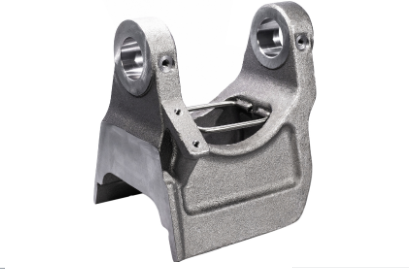Mining Machinery Precision Casting Components: Advantages and Applications
Mining machinery precision casting components are an essential part of the mining industry. These components are used in various mining machinery such as excavators, loaders, and drilling machines. Precision casting is a manufacturing process that involves creating complex parts with tight tolerances and high accuracy. This process is ideal for creating mining machinery components that require high strength, durability, and resistance to wear and tear.
Precision casting components offer several advantages over other manufacturing methods. They are more accurate, have better surface finish, and are more durable. This makes them ideal for use in harsh mining environments. Additionally, precision casting allows for the creation of complex shapes and intricate designs that are difficult to achieve with other manufacturing methods. This means that mining machinery components can be designed to meet specific requirements and perform better than their counterparts made using other methods.
Overall, mining machinery precision casting components are an essential part of the mining industry. They offer several advantages over other manufacturing methods and are ideal for creating durable, high-performance mining machinery components. As the mining industry continues to grow, the demand for precision casting components is expected to increase, making it an exciting time for manufacturers in this field.
Overview of Mining Machinery Precision Casting Components
Mining machinery precision casting components are an essential part of mining equipment. They are used to make mining machinery more efficient, durable, and reliable. Precision casting is a manufacturing process that involves producing complex parts with high precision and accuracy. The process involves pouring molten metal into a mold to create a part that is dimensionally accurate and has a smooth surface finish.
Types of Components
Mining machinery precision casting components are used in various parts of mining machinery. Some of the most common components include:
- Gearbox housings
- Hydraulic pumps and valves
- Brake drums and discs
- Engine blocks and cylinder heads
- Bearing housings
- Flywheels and clutch plates
- Idler wheels and track shoes
- Rollers and sprockets
Importance of Precision Casting
Precision casting is essential in the production of mining machinery components because it ensures that the parts are dimensionally accurate and have a smooth surface finish. This accuracy and smoothness are crucial for the proper functioning of mining machinery. Precision casting also allows for the production of complex parts that cannot be made using other manufacturing processes.
Mining machinery components made using precision casting are also more durable and reliable than those made using other manufacturing processes. This is because precision casting produces parts with fewer defects and inconsistencies, which can lead to premature failure of the parts. The use of precision casting also ensures that the parts are made from high-quality materials, which further enhances their durability and reliability.
In conclusion, mining machinery precision casting components are an essential part of mining equipment. They are used to make mining machinery more efficient, durable, and reliable. The use of precision casting ensures that the parts are dimensionally accurate, have a smooth surface finish, and are made from high-quality materials.
Key Considerations for Mining Machinery Precision Casting Components
Material Selection
When it comes to mining machinery precision casting components, material selection is crucial. The right material can ensure that the component performs optimally and lasts as long as possible. Some key factors to consider when selecting a material include:
- Strength and durability
- Corrosion resistance
- Heat resistance
- Wear resistance
- Machinability
Common materials used for mining machinery precision casting components include stainless steel, carbon steel, and alloy steel. Each material has its own unique properties and should be carefully selected based on the specific needs of the component.
Design and Engineering
The design and engineering of mining machinery precision casting components is another important consideration. Components should be designed with the specific application in mind, taking into account factors such as load capacity, stress, and temperature. Additionally, components should be designed to be easily machinable and assembled.
Computer-aided design (CAD) software can be a valuable tool for designing and engineering mining machinery precision casting components. CAD software allows designers to create 3D models of components, test their performance under various conditions, and make modifications as needed.
Manufacturing Processes
The manufacturing process used for mining machinery precision casting components can also have a significant impact on their performance and lifespan. Some key considerations when selecting a manufacturing process include:
- Casting method (e.g. sand casting, investment casting)
- Heat treatment
- Machining techniques
- Quality control measures
Investment casting is a popular choice for mining machinery precision casting components due to its ability to produce complex shapes with high accuracy and surface finish. Heat treatment can also be used to improve the strength and durability of components.
Overall, careful consideration of material selection, design and engineering, and manufacturing processes is essential for ensuring the optimal performance and longevity of mining machinery precision casting components.
Quality Control for Mining Machinery Precision Casting Components
Inspection and Testing
Quality control is an essential aspect of manufacturing precision casting components for mining machinery. The inspection and testing process ensures that the components meet the required specifications and are fit for their intended use.
During the production process, each component undergoes a series of inspections and tests to ensure that it meets the required standards. These inspections and tests may include visual inspections, dimensional checks, and non-destructive testing (NDT) methods such as X-ray and ultrasonic testing.
In addition to in-process inspections, a final inspection is carried out on each component before it is shipped to the customer. This final inspection verifies that the component meets all the required specifications and is free from defects.
Certifications and Standards
Mining machinery precision casting components must meet various certifications and standards to ensure their quality and safety. These certifications and standards vary depending on the component’s intended use and the location where it will be used.
Some common certifications and standards that mining machinery precision casting components must meet include ISO 9001, ISO 14001, and OHSAS 18001. These certifications ensure that the manufacturer has implemented a quality management system, an environmental management system, and an occupational health and safety management system.
Other certifications and standards that may be required include ASME, ASTM, API, and NACE. These certifications and standards ensure that the component meets specific requirements for materials, design, and performance.
In conclusion, quality control is a critical aspect of manufacturing mining machinery precision casting components. The inspection and testing process, along with meeting various certifications and standards, ensures that the components are of high quality and meet the required specifications.
Maintenance and Repair of Mining Machinery Precision Casting Components
Common Issues and Solutions
Mining machinery precision casting components are subject to wear and tear due to the harsh working environments they operate in. Some common issues that may arise include cracks, corrosion, and wear on the surface. To ensure optimal performance and longevity, it is important to identify and address these issues promptly.
One common issue is cracking, which can occur due to excessive stress or thermal shock. To address this, the damaged area must be identified and repaired using welding or brazing techniques. Corrosion is another issue that can lead to component failure. Regular cleaning and coating with anti-corrosion agents can help prevent this.
Wear on the surface of components can lead to reduced performance and efficiency. To address this, worn parts must be replaced with new ones or repaired using welding or brazing techniques. It is important to ensure that the replacement parts are of high quality and compatible with the existing components.
Preventative Maintenance
Preventative maintenance is crucial to ensure the optimal performance and longevity of mining machinery precision casting components. This includes regular cleaning, inspection, and lubrication. It is also important to identify and address any potential issues before they become major problems.
Regular cleaning can help prevent the buildup of dirt, debris, and other contaminants that can cause damage to components. Inspection should be carried out regularly to identify any signs of wear, corrosion, or other issues. Lubrication is also important to ensure that components operate smoothly and efficiently.
In addition to regular maintenance, it is important to ensure that the components are operated within their specified parameters. This includes monitoring the temperature, pressure, and other operating conditions to ensure that they are within the recommended range.
Overall, maintenance and repair of mining machinery precision casting components is crucial to ensure optimal performance and longevity. By identifying and addressing potential issues promptly and carrying out regular preventative maintenance, operators can ensure that their equipment operates efficiently and reliably for years to come.

